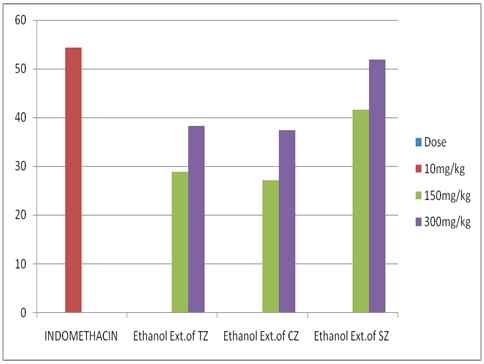Comparative Evaluation of in vitro Anti-Inflammatory Activity of Selected Medicinal Plants from Andhra Pradesh
Abstract
An in vitro anti-inflammatory activity of three different medicinal plants growing around Chevuturuvillage, Mylavaram, Andhra Pradesh was tested in the current study. Each plant extract was subjected to phytochemical analysis. Two methods were used to assess anti-inflammatory activity: Carrageenan-induced rat paw oedema, Dextran-induced rat paw oedema, and cotton pellet-induced granuloma are the three conditions studied. T cordifolia has the potential to be used as an anti-inflammatory and antipyretic medication in the future, according to this study. The presence of several phytoconstituents in extracts of Trichodesma zeylanicum, Sansevieria zeylanica, and Capparis zeylanica may be responsible for this activity. Anti-inflammatory activity was comparable to that of standard medications, according to the statistical analysis. The findings suggest that Capparis zeylanica root bark has anti-inflammatory effects.
Full text article
References
G Majno. The Healing Hand: Man and Wound in the Ancient World. pages 121–129, 1975. Harvard University Press, Cambridge.
H W Florey. General Pathology. Lloyd-Luke, London. pages 21–26, 1962.
Ashwini Kumar and Baidyanath Kumar. Biosystematic Studies in Heliotropium indicum, Trichodesma indicum and T. zeylanicum of Boraginaceae. 5:720–729, 2016.
J M Watt, M K Breyer, and M G Brandwijk. The Medicinal and Poisonous Plants of Southern and Eastern. pages 242–248, 1962.
M M Iwu. Handbook of African medicinal plants. pages 172–176, Raton, Florida, USA, 1993. CRC Press Boca.
V R Mohana, A Rajesh, T Athiperumalsamia, and S Sutha. Ethnomedicinal plants of the tirunelveli district. volume 12, pages 79–95, 2008.
B E Van Wyk, Oudtshoorn, and N Gericke. Medicinal plants of South Africa. Briza. Pretoria, ISBN:1–875093, 1997.
P Rajesh, P Selvamani, S Latha, A Saraswathy, and V R Kannan. A review on chemical and medicobiological applications of Capparidaceae family. Phcognosy Review, 3:378–387, 2009.
J B Harborne. Phytochemical Methods. A Guide to Modern Techniques of Plant Analysis. pages 1–226, London, 1988. Chapman and Hall.
D J Ecobichon. The Basis of Toxicology Testing. pages 43–86. CRC Press, 1997.
C A Winter, E A Risley, and G W Nuss. Carrageenin induced oedema in hind paw of the rat as an assay for anti-inflammatory drugs. 1962.
M Merlos, L A Gomez, L Vericat, J Garcia- Rafanell, and J Forn. Comparative study of the effect of CV-6909, a specific PAF-antagonist, on rat paw oedema caused by different phlogogen agents. Pharmcology, 40:211–217, 1990.
C A Winter and C C Porter. Effect of alteration in side chain upon anti-inflammatory and liver glycogen activities in hydrocortisone esters. J Am Pharm Assos, 46:515–519, 1957.
M Rosa and D A Willoughby. Screens for anti-inflammatory drugs. J Pharm Pharmacol, 23:297–298, 1971.
K F Swingle and F E Shideman. Phases of the inflammatory response to subcutaneous implantation of cotton pellet and their modification by certain anti-inflammatory drugs. J Pharmacol Exp Ther, 183:226–234, 1972.
E Arrigoni-Martellie. Inflammation and Anti- inflammatory. pages 110–120, New York, 1977. Spectrum Publications Inc.
Authors
Copyright (c) 2023 International Journal of Research in Pharmaceutical Sciences

This work is licensed under a Creative Commons Attribution-NonCommercial-NoDerivatives 4.0 International License.





